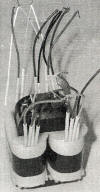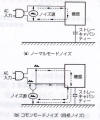Hashimoto engineers prefer the total approach for its product design - examining
every possible part to use, testing the optimum measurable characteristics of
its products, and finally auditioning the sonic results - the most critical
criteria. Even if a new product displays the best measurable
characteristics, this product could
be rejected if it is sonically
inferior to other possible products. In other words, the top priority of Hashimoto transformer design is to obtain the most
real-life-like music sound based on their accumulated technologies and proven
methodologies. Hashimoto engineers prefer the step-by-step approach rather
than putting too much emphasis on merely expensive
or exotic material. For example, Hashimoto engineers intentionally avoid
using silver wire because they have discovered that it actually worsens the sound compared with
the traditional copper wire. Another good
example is Hashimoto does not use permalloy cores. This is because permalloy
cores are weak in lower frequency, thus the final sound tends to be unbalanced even
though permalloy cores yields beautiful high to mid-range sound.
Hashimoto's sonic orientation has been a long term goal and tradition from
the Sansui era. Mr. Ichiro Ohshima who was a high-end product manager at
Sansui from mid 1980's to 2000 mentioned to me that "It's easy to design an
amplifier that has excellent measurable characteristics. But, it's very
difficult to build an amplifier that sounds good under the same technical
characteristics." Because of this pursuit in "good
sound" philosophy, Sansui put so many efforts to eliminate two major
sources of sound distortions; physical vibrations and grounding issues throughout the
1990's.
As Sansui engineers has pursuit, Hashimoto engineers put great emphasis on eliminating the
physical vibrations and shutting-off the external electrical noises. Hashimoto
engineers believe these are two major elements of making significant differences
into the better sound. For example, Hashimoto output/input
transformer cores are filled in pitch rather than stored in the solid
plastic or epoxy because Hashimoto engineers discovered that the oil based pitch
is better material to absorb the physical vibrations.
Another good example is Hashimoto MC transformers consist of three layers of
internal insulations with
two different density of micro-wax to minimize the absorption of external vibrations as well as
electro-magnetic noises.
Even before Hashimoto started its branded tube transformer business, Hashimoto
has been producing the hospital-grade power
transformers that require the lowest noise level in order to supply the cleanest
power to the sensitive medical equipments. The essence of this technology
is so called "Multiple Balanced Shield," and Hashimoto took advantage of this
technology to design its choke coils and power transformers to yield very low
hum and noise level. As the result, the combination of Hashimoto power supply transformers and signal pass transformers yield the optimum sound quality with the lowest
hum, noise, and vibration inferences. This is the exact reason why
Hashimoto recommends to use all Hashimoto transformers in an amplifier.
As
being previously mentioned, Hashimoto engineers intentionally avoid to use permalloy
or amorphous cores. This is because they have determined that the Oriental
Core Hi-B would yield better and more balanced sound quality if other important
factors; such as the core windings, the isolation and filling material, and the
overall case design, are designed correctly.
Hashimoto core winding techniques which have been accumulated over 60 years
of experiences should be the ultimate asset
for Hashimoto engineers. Hashimoto inherited the top quality transformer
technologies from Sansui in the late 1970's, then Hashimoto has further fine
tuned the skills for the last thirty some years. In
essence, the core winding techniques are the result of numerous tries and errors.
This is the place where accumulated experiences should count the most, and this is the
place where subtle sonic differences will appear depending upon the depth of
engineers skills.
The ultimate goal of core winding technique is to determine the best scheme
of minimizing the leakage inductance and the stray capacitance. The
leakage inductance can be reduced by alternatively mixing the primary and the
secondary windings in several layers; this is called the horizontal dividing
method. However, too many horizontal layers will increase the stray
capacitance. In order to reduce the stray capacitance, the secondary
windings can be divided into sections in each layer; this is called the vertical
dividing method. However, at this time, too many vertical dividing will
increase the leakage inductance. Therefore, Hashimoto engineers have to
determine the optimum point of mixing the horizontal and the vertical dividing
methods. Especially for a high-primary-impedance transformer, too many
horizontal dividing will increase undesirable stray capacitance; thus, the
technique of vertical dividing becomes an essential factor to design a high
quality high-primary-impedance transformer.
 The relationship between the Horizontal and the Vertical Dividing Methods: from
MJ Feb 2002 Issue, Page 133
The relationship between the Horizontal and the Vertical Dividing Methods: from
MJ Feb 2002 Issue, Page 133
Another issue which makes the core winding more complex is the fact that Hashimoto output
transformer secondary has 4, 8, and 16 Ohms outputs. These three
independent output windings could slightly increase the leakage inductance due
to the unused section of output windings. Hashimoto engineers solve this
issue with further elaborated core winding techniques.
Beside the core winding technique itself, there are many other issues
Hashimoto engineers need to give their attentions to. For example, in order
to secure the horizontally and vertically divided coil, Hashimoto has adopted
the custom made paper
for the insulation material. For Single-Ended transformers, Hashimoto
engineers uses polyester films for a core spacer (SE transformers need a core spacer
to avoid the magnetic saturation caused by B+ DC current). The reason why
Hashimoto uses pitch for the filling material has been mentioned in the previous
section. Finally, Hashimoto engineers have designed the outer case and
chosen its material in consideration of minimizing the external physical vibrations and
magnetic interferences.
As being described before, Hashimoto transformers are the result of the total
efforts to obtain the best possible sonic performances after the optimum measurable
characteristics have been archived. In this sense, Hashimoto transformers
require the highest attention to the details to build, and they are nothing but
an art created by skilled craftsmen.
3. Input / Interstage Transformers
The basic construction of Input / Interstage transformers is very similar to
that of output transformers except these transformers have a single Orient Core
Hi-B in the core type construction. This is because Input / Interstage
transformer require the low-noise characteristic rather than the power
efficiency. Because Hashimoto Input / Interstage transformers allow users
to configure in different impedance settings, the internal windings become extremely complex.
 Inside of Input / Interstage Transformer: from MJ Feb 2002 Issue, Page 136
Inside of Input / Interstage Transformer: from MJ Feb 2002 Issue, Page 136
4. Power Transformers
Hashimoto power transformers adopted a cold rolled, 0.5mm Hi-Light Core,
which is non-directional silicon steel, to form the I-E core. As being
already described, Hashimoto power transformers are the direct result of
experiences obtained by developing the
larger / higher-powered hospital-grade power transformer technologies. The
significant benefit of the "Multiple Balanced Shield" technology is the
minimization of both the normal mode and the common mode noises. These
noises are caused by the
stray capacity being generated between the transformer and
the ground. According to the data from Hashimoto Electric, the noise
improvement with the "Multiple Balanced Shield" shows a significant 35dB
difference compared with transformers without the "Multiple Balanced Shield".
 The Normal Mode (a) and Common Mode (b) Noises: from MJ Feb 2002 Issue, Page 138
The Normal Mode (a) and Common Mode (b) Noises: from MJ Feb 2002 Issue, Page 138
Besides the "Multiple Balanced Shield" that insulates between the
primary and the secondary windings, both a copper
short-ling and a silicon steel hum-proof belt around the coil and the core
prevent from its own noise leakages. To improve the electrical
insulation, Hashimoto engineers adopted the hospital-grade insulation
materials. Finally, to minimize the chance of over-heating, every
Hashimoto power transformer contains an internal 130C heat fuse.
 Inside of Power Transformers: from MJ Feb 2002 Issue, Page 137
Inside of Power Transformers: from MJ Feb 2002 Issue, Page 137
5. Choke Coils
The materials being used in Hashimoto Choke Coils are very similar to those
of Hashimoto Power Transformers; the same core and the same insulation
materials. One unique feature that should be mentioned here is Hashimoto
Choke Coils can be set at one of two selectable inductance levels.
 Inside of Choke Coil: from MJ Feb 2002 Issue, Page 139
Inside of Choke Coil: from MJ Feb 2002 Issue, Page 139
[ Home |
Search]

Last changed:
02/01/15
![]()